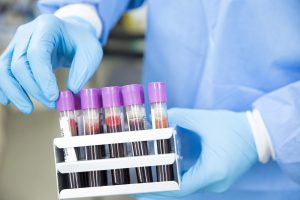Print a Sign-In Sheet | Spanish Version Coming Soon
Employees exposed to blood or other potentially infectious materials (OPIM) are protected under the Occupational Safety and Health Administration’s (OSHA) Bloodborne Pathogens Standard (29 CFR 1910.1030). Employers must determine which employees have workplace exposure, and a written Exposure Control Program must then be put into place. The goal of the program is to eliminate or reduce employee exposure. The program must be reviewed at least annually and be available to all employees. The review should be documented along with any updates to the plan. The employer must also document the use and consideration of safer medical devices and seek the opinion of employees that are responsible for direct patient care. The Bloodborne Pathogens Standard also requires employees to be trained over the program. This training must be free of charge and during their normal working hours.
It is imperative to practice universal precautions. The practice of universal precautions means treating all blood or OPIM as though it is infectious. The most common bloodborne pathogens are HIV, HBV, and HCV. The implementation of engineering and work practice controls should be practiced first. An example would be using safer medical devices or retractable needles. It is also important to wear appropriate personal protective equipment (PPE), such as masks, gowns, eye protection, splash shields, gloves, etc. All PPE should be taken off and placed in appropriate containers prior to leaving the work area. The PPE should be properly cleaned, decontaminated, or disposed of. It is extremely important to thoroughly wash hands following any situation where an employee encounters blood or OPIM.
Remember, exposure occurs when blood or OPIM makes entry into the eyes, nose, mouth, mucous membranes, or an opening/break in the skin. If exposure occurs, the employee should be immediately and confidentially evaluated by a health care professional. The appointment usually consists of blood testing, a medical evaluation, and a couple of additional follow-up visits. This testing and medical evaluation is to be provided at no charge to the employee. The health care professional must provide a written opinion.
A sharps log should be maintained by the employer documenting any exposures through needle sticks or other forms of sharps. A sharp is any object that can break the skin and is contaminated with blood or OPIM. Some examples of sharps are needles, broken glass, and scalpels. Employers should have biohazard sharps containers to place contaminated sharps. The containers should have biohazard labels. Also, any refrigerators or freezers where regulated waste is stored must have biohazard labels/symbols. All regulated medical wastes, not just sharps, should be placed in biohazard waste containers and have biohazard labeling.
When employees have occupational exposure to blood or OPIM, the employer must offer those employees the hepatitis B vaccine. It is a three-dose series of injections. It should be offered after the employee has received the required training and within 10 days of their initial assignment. There is an exception if the worker has already completed the vaccine series, antibody testing shows they have immunity, or it is unsafe due to personal medical reasons. The vaccine is to be provided to the employee free of charge. The employee may decline the vaccine; however, the employee must sign a declination form. At any time, the employee may change their mind and request the vaccine at no charge to them. Approximately one or two months following completion of the vaccine series, the employer should offer antibody testing. If the employee does not respond to the primary vaccine series, a second series of injections and retesting must be offered.
Employers have certain recordkeeping requirements as well. A record must be maintained of all employee training, hepatitis B vaccine documentation, and all related medical records and evaluations resulting from/related to an exposure incident. The medical records must be kept for at least the length of employment plus 30 years. The training records are required to be kept for three years from the date the training took place. The medical and training records should be made available upon request to the employee. If the employee has given written consent to an employee representative, then records must also be provided to that individual. In addition, medical and training records must be made available upon request to the Director of the National Institute of Occupational Safety and Health (NIOSH) or the Assistant Secretary of Labor for the Occupational Safety & Health Administration (OSHA).
Source: United States Department of Labor. Occupational Safety & Health Administration. Hospital eTool. Healthcare Wide Hazards. Bloodborne Pathogens. Retrieved from:
https://www.osha.gov/SLTC/etools/hospital/hazards/bbp/bbp.html#PPE
KEMI does not assume liability for the content of information contained herein. Safety and health remain your responsibility. This information is to be used for informational purposes only and not intended to be exhaustive or a substitute for proper training, supervision, or manufacturers’ instructions/recommendations. KEMI, by publication of this information, does not assume liability for damage or injury arising from reliance upon it. Compliance with this information is not a guarantee or warranty that you will be in conformity with any laws or regulations nor does it ensure the absolute safety of any person, place, or object, including, but not limited to, you, your occupation, employees, customers, or place of business.

